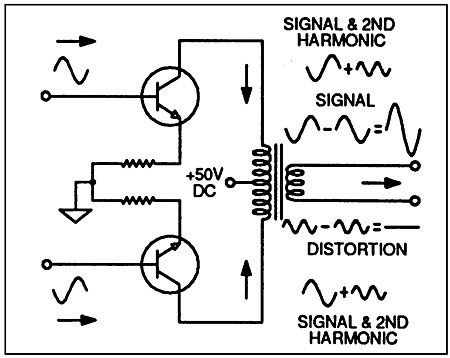| Columns Retired Columns & Blogs |
Boulder 500AE power amplifier Complementary Symmetry
Sidebar 3: Complementary Symmetry
Footnote 1: True push-pull operation is automatically invoked when two solid-state amplifiers (including the 500AE) are "bridged" for mono operation.
The complementary-symmetry circuit is sometimes called complementary push-pull, but strictly speaking, push-pull operation always means two identical output devices handling the same audio signal in relative inverted polarity. The output from these devices is their difference signal, which means out-of-phase signals—the music—produce maximum output while in-phase signals—even-order distortion and common-mode noise—cancel to produce zilch. Fig.1 shows how this works (in theory).

Fig.1 Simplified circuit of a push-pull transistor output stage.
Opposite-polarity input signals are both inverted by amplification, but the tubes' even-order distortion products (of which only the second is shown here) are in-phase. The center-tapped output transformer performs electrical subtraction of identical signals fed to both ends of it that is, it draws off the difference signal. Subtracting the antiphase audio signals is equivalent to adding them in-phase: The signals reinforce one another to produce twice the output voltage (+6dB) of each one individually. The even-order harmonics, being in-phase, cancel one another when subtracted. Odd-order harmonics appear at the device outputs in-phase with one another, and are treated like the signal outputs: they are not canceled, but are reinforced by 6dB. Because the signals are also increased by 6dB, the harmonics remain at their original percentage of the signal.
In practice, the distortion cancellation is dependent on the devices' operating class. When these are biased for class-A operation, in which current flows through both devices all the time, the amount of even-order distortion cancellation is limited only by the electrical symmetry between the out-of-phase signal components and between the two halves of the output transformer primary. Class-B "push-pull" operation, where each half of the circuit is switched off during half of the input-signal cycle, does not meet the mirror-imaging requirement of true push-pull, and does not cancel distortion. (Neither does class-B cancel the DC magnetic fields caused by current flow through the output transformer.)
Fig.2 shows a typical complementary-symmetry transistor output stage running in class-B (footnote 2). Here the input signals are in-phase, and the active devices' opposite "polarity" allows them to access power supplies of opposite polarity. Since their outputs are summed, signal reinforcement occurs but there is no cancellation of harmonic distortion.

Fig.2 Simplified circuit of a complementary symmetrical emitter-follower output stage biased to run in class-B.
How subjectively important is the cancellation of even-order harmonics by push-pull class-A operation? The strongest harmonic produced by a tube is the second: ie, an additional tone one octave above that fed into its grid appears at the tube's output. The lower even-order harmonics add some forwardness to the sound, but this is not an unpleasant coloration unless the loudspeakers tend to be overly forward to begin with. Odd-order harmonics, as well as the higher even orders (6th, 8th, etc.), add a steely edge to the sound which is rarely pleasant. But unlike many bipolar transistors—which tend to generate almost as much 6th-harmonic distortion as 2nd—a tube's distortion tends to diminish with ascending order. (My ears tell me FETs are more like tubes in this respect.) So the harmonic-distortion–canceling aspects of push-pull operation are probably overrated, even though push-pull does significantly lower the amplifier's measured THD figure (footnote 2). But the fact that, despite even-order cancellations, push-pull tube amplifiers still have vastly higher measured THD than good transistor amps, may explain why they so often have a harder, brighter sound than most solid-state ones.
The differences between the relative intensities of the high-order harmonics is an inherent difference between tubes and most transistors, and is one reason why tubes almost always sound softer and sweeter at the extreme high end, while transistors sound crisper and more open at the top. It is also why I have long argued that the ever-popular THD specification is virtually meaningless as a performance criterion, and that a harmonic-by-harmonic analysis, by percentage, would do a much better job of defining how an amplifying device will actually sound (footnote 3).—J. Gordon Holt
Footnote 1: True push-pull operation is automatically invoked when two solid-state amplifiers (including the 500AE) are "bridged" for mono operation.
Footnote 2: As a matter of fact, push-pull operation was originally conceived merely as a way of increasing power output, the reasoning being that two oppositely phased power tubes can produce twice as much voltage swing as one. The distortion reduction was only a welcome side-effect of this.
Footnote 3: Their continuing reliance on a simple THD spec is why I became convinced that the mass-market magazines, Stereo Review in particular, which have always contended that measurements can define sonic quality, were not really interested in publishing measurements that would in fact do that. I'm gratified to see that Stereophile is publishing such harmonic-series breakdowns, although it would seem to make more sense to convert the deciBel figures on the Y scale of our graphs into percentages, since that's how most of us are accustomed to thinking about harmonic content.
- Log in or register to post comments




































